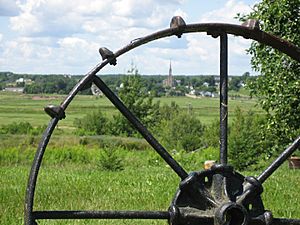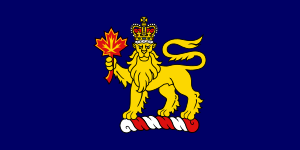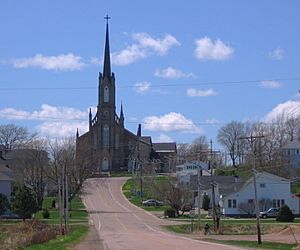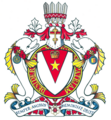Roméo LeBlanc facts for kids
Quick facts for kids
Roméo LeBlanc
|
|
|---|---|
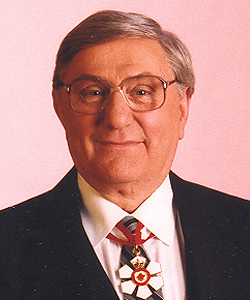 |
|
| 25th Governor General of Canada | |
| In office February 8, 1995 – October 7, 1999 |
|
| Monarch | Elizabeth II |
| Prime Minister | Jean Chrétien |
| Preceded by | Ray Hnatyshyn |
| Succeeded by | Adrienne Clarkson |
| More... | |
| Personal details | |
| Born |
Roméo-Adrien LeBlanc
December 18, 1927 Memramcook, New Brunswick, Canada |
| Died | June 24, 2009 (aged 81) Grande-Digue, New Brunswick, Canada |
| Political party | Liberal |
| Spouses |
|
| Children | Dominic LeBlanc Genevieve LeBlanc |
| Profession | Politician, Journalist, Teacher |
| Signature | |
Roméo-Adrien LeBlanc (December 18, 1927 – June 24, 2009) was an important Canadian figure. He was a journalist, a politician, and a statesman. From 1995 to 1999, he served as the Governor General of Canada. He was the 25th person to hold this role since Canada became a country.
LeBlanc grew up and went to school in New Brunswick. He also studied in France. Before becoming a politician, he worked as a teacher and then as a reporter for Radio-Canada. In 1972, he was elected to the House of Commons of Canada. He then served as a government minister until 1984. After that, he moved to the Senate of Canada and became its Speaker.
In 1995, Queen Elizabeth II chose him to be the Governor General. This was suggested by Prime Minister Jean Chrétien. He took over from Ray Hnatyshyn and served until 1999. He stepped down due to his health. Some people thought his appointment was political favoritism. However, he was praised for helping to raise the profile of Acadians and French-speaking Canadians. He also brought Rideau Hall, the Governor General's home, back to the center of life in Ottawa.
Roméo LeBlanc passed away on June 24, 2009, at the age of 81.
Contents
Roméo LeBlanc's Early Life and Career
Roméo LeBlanc was born on December 18, 1927, in Memramcook, New Brunswick. He grew up there. He earned degrees in arts and education from Collège St-Joseph. He also studied French culture in Paris, France.
After his studies, he taught for nine years. He taught at Drummond's high school and the New Brunswick Teachers' College. From 1960 to 1967, he worked as a journalist. He reported for Radio-Canada in Ottawa, the United Kingdom, and the United States.
LeBlanc had two children, Genevieve and Dominic LeBlanc, with his first wife, Joslyn "Lyn" Carter. They were married from 1966 to 1981. In 1994, he married Diana Fowler.
Stepping into Politics
LeBlanc started in politics as a press secretary. He worked for Prime Ministers Lester B. Pearson and Pierre Trudeau. In 1972, he was elected to the House of Commons of Canada. He represented the area of Westmorland-Kent for the Liberal Party of Canada.
He then became the Minister of Fisheries and Oceans. In this role, he made big changes to fishing rules in Canada.
- He helped create a 200-mile fishing zone for Canada. This protected Canadian waters.
- He set up new fishing licenses and quotas. This helped protect Canadian fishermen from large companies.
- He made sure that license holders had to operate their own fishing boats.
- He also stopped foreign companies from holding commercial fishing licenses in Canada.
LeBlanc even convinced Prime Minister Trudeau to close Canadian ports to Soviet fishing vessels once. This helped improve cooperation in fishing. On the Pacific coast, he started a program to increase salmon production.
In 1982, LeBlanc became the Minister of Public Works. Two years later, in 1984, he was appointed to the Senate of Canada. In 1993, Prime Minister Jean Chrétien chose him to be the Speaker of the Senate of Canada.
Roméo LeBlanc as Governor General
LeBlanc's time as Governor General was seen as calm and steady. He was the first Governor General from Acadian heritage. This was a big moment for the Acadian community. He was also the first from the Canadian Maritimes region to hold the role.
Becoming the Governor General
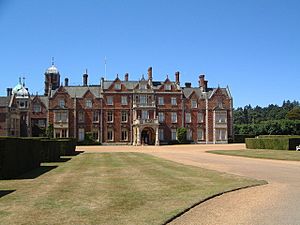
On November 22, 1994, it was announced that Queen Elizabeth II had approved Roméo LeBlanc as the next Governor General. He was chosen by Prime Minister Jean Chrétien.
LeBlanc met with the Queen at Sandringham House. He was very impressed by her dedication to her duties. His official appointment was made on January 16, 1995.
His appointment caused some discussion. Some people thought it was a political reward because he was a strong supporter of the Liberal Party. Because of this, the leaders of the Reform Party and Bloc Québécois did not attend his installation ceremony.
His Time in Office
As Governor General, LeBlanc chose to focus on certain areas. These included:
- Promoting volunteering
- Teaching Canadian history
- Supporting Canada's Aboriginal peoples
- Honoring the military
He often spoke about how generous, tolerant, and caring Canadians are.
In 1996, LeBlanc started the Governor General's Caring Canadian Award. This award recognized "unsung heroes" who volunteer to help others. On June 21, 1996, he also announced that National Aboriginal Day would be celebrated every year.
He also created the Governor General's Award for Excellence in Teaching Canadian History in 1996. In 1999, he helped create the Governor General's Awards in Visual and Media Arts.
LeBlanc traveled all over Canada. He especially liked visiting small towns and cities. He made many visits to Quebec after the 1995 referendum on separation. He took part in over 2,000 events. He also moved the annual New Year's Levée to different cities each year.
He also made Rideau Hall, the Governor General's official residence, more open to the public. He opened a special visitors' center in 1997. This helped the number of visitors triple to about 125,000 people each year. He also placed a totem pole and an inukshuk on the grounds to honor Canada's First Peoples.
LeBlanc performed many official duties. He signed changes to the Constitution of Canada three times. He also announced the creation of the territory of Nunavut in 1999. He welcomed many important guests to Rideau Hall. These included Queen Elizabeth II, Prince Philip, and Prince Charles. He also hosted leaders like US President Bill Clinton, King Hussein of Jordan, and President Nelson Mandela of South Africa.
He also made eight state visits to other countries. He was the first Governor General to visit countries like the Czech Republic, India, and Pakistan.
His Legacy
As Governor General, Roméo LeBlanc was seen as a role model for Acadians. He helped bring attention to Acadian history and culture. He was also praised for making Rideau Hall a more important place in the capital city.
LeBlanc made a small change to the Flag of the Governor General of Canada. He removed the claws and tongue from the lion on the flag. He felt they were impolite and not very Canadian. This change was later undone by his successor.
After Being Governor General
After his time as Governor General, Roméo LeBlanc returned to New Brunswick. He had a long battle with Alzheimer's disease. He passed away on June 24, 2009, in Grande-Digue.
He received a state funeral, which is a special ceremony for important leaders. It took place on July 3, 2009, in Memramcook. Officers from the Department of Fisheries and Oceans lined the path of his casket. This honored his time as the Minister of Fisheries. The sitting Governor General, Michaëlle Jean, Prime Minister Stephen Harper, and former Prime Minister Jean Chrétien all attended.
In 2010, Canada Post honored Roméo LeBlanc by featuring him on a postage stamp.
Honours and Awards
Roméo LeBlanc received many honors and awards throughout his life. These recognized his service to Canada.
- Appointments
- He was a Member of Parliament (MP) from 1973 to 1984.
- He was a member of the Queen's Privy Council for Canada from 1974 until his death.
- He was the Chancellor and Principal Companion of the Order of Canada while Governor General.
- He was the Chancellor and Commander of the Order of Military Merit (Canada) while Governor General.
- He was a Knight of Justice of the Venerable Order of Saint John.
- He was the Chief Scout of Canada from 1995 to 2000.
- He was a Member of the Order of New Brunswick.
- Medals
- He received the Commemorative Medal for the 125th Anniversary of the Confederation of Canada in 1992.
- He received the Canadian Forces Decoration in 1995.
- He received the Queen Elizabeth II Golden Jubilee Medal in 2002.
- Foreign honours
- He was a Grand Officer of the Ordre national du Mérite from France.
Honorary Degrees
Roméo LeBlanc also received many honorary degrees from universities across Canada. These degrees recognized his achievements and contributions.
- Geographic locations
- LeBlanc Park in Memramcook, New Brunswick is named after him.
- The Greater Moncton Roméo LeBlanc International Airport in Dieppe, New Brunswick is also named in his honor.
Images for kids
-
Roméo LeBlanc's personal coat of arms
See also
 In Spanish: Roméo LeBlanc para niños
In Spanish: Roméo LeBlanc para niños
- List of people from Westmorland County, New Brunswick
- Journalism


